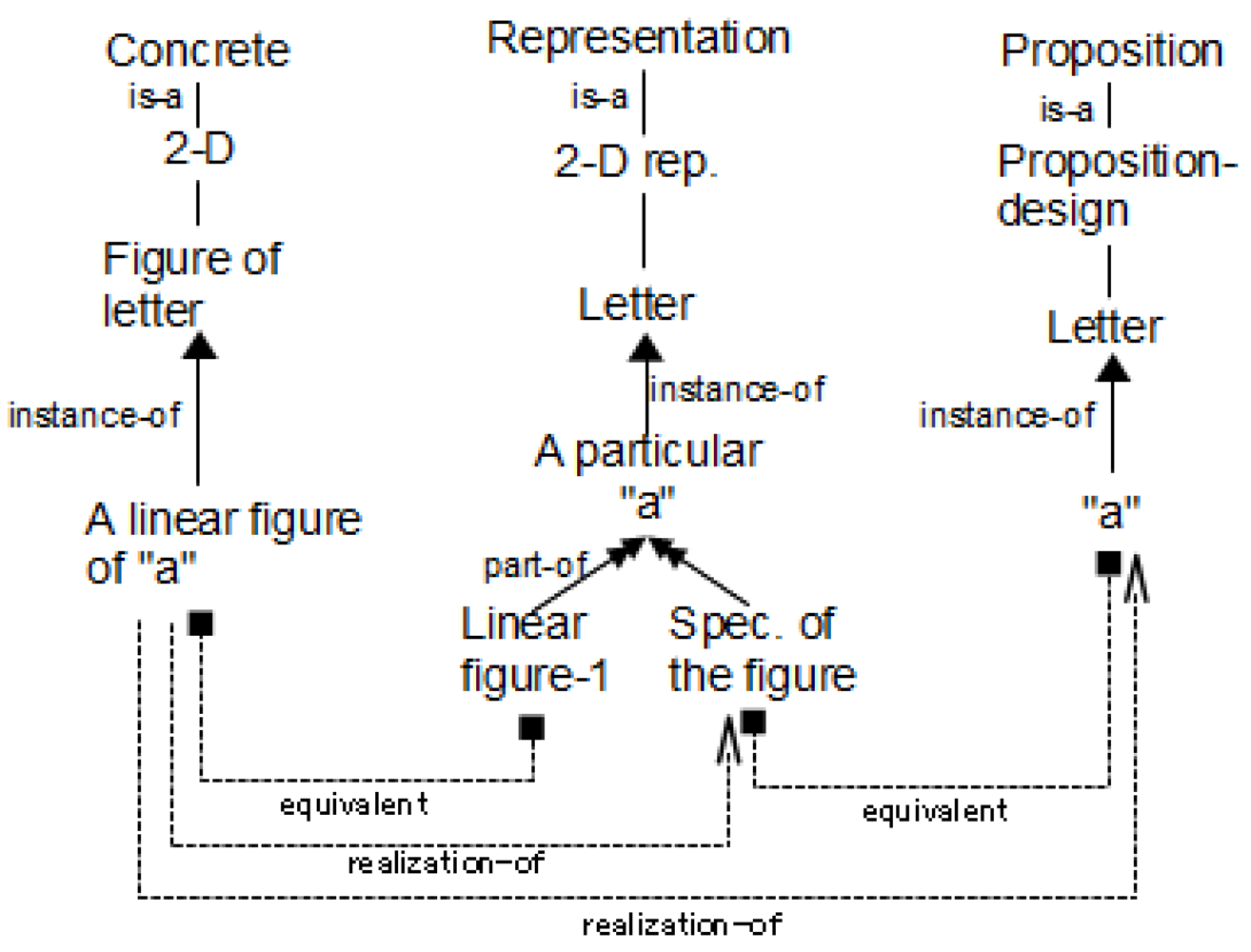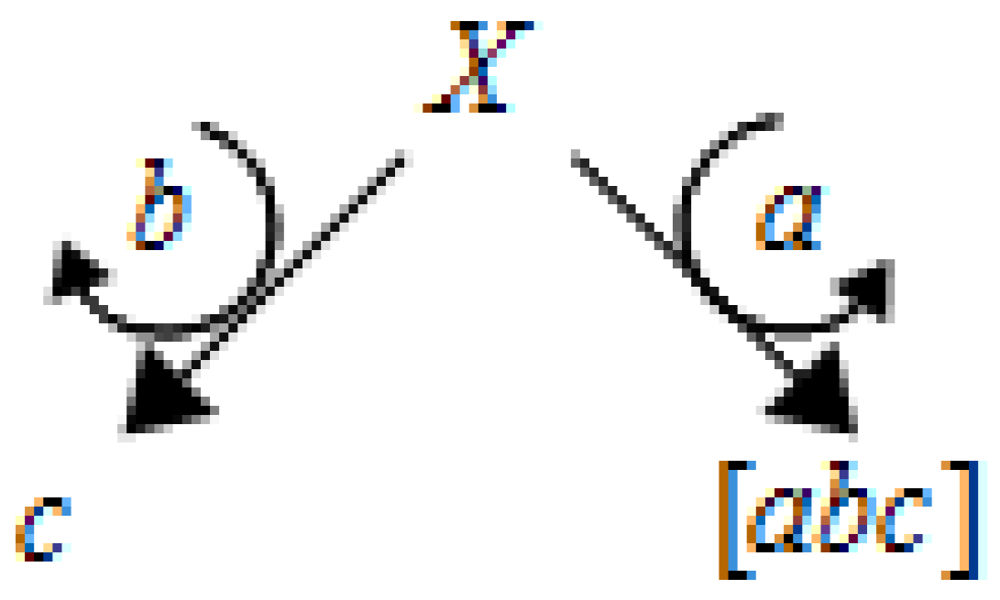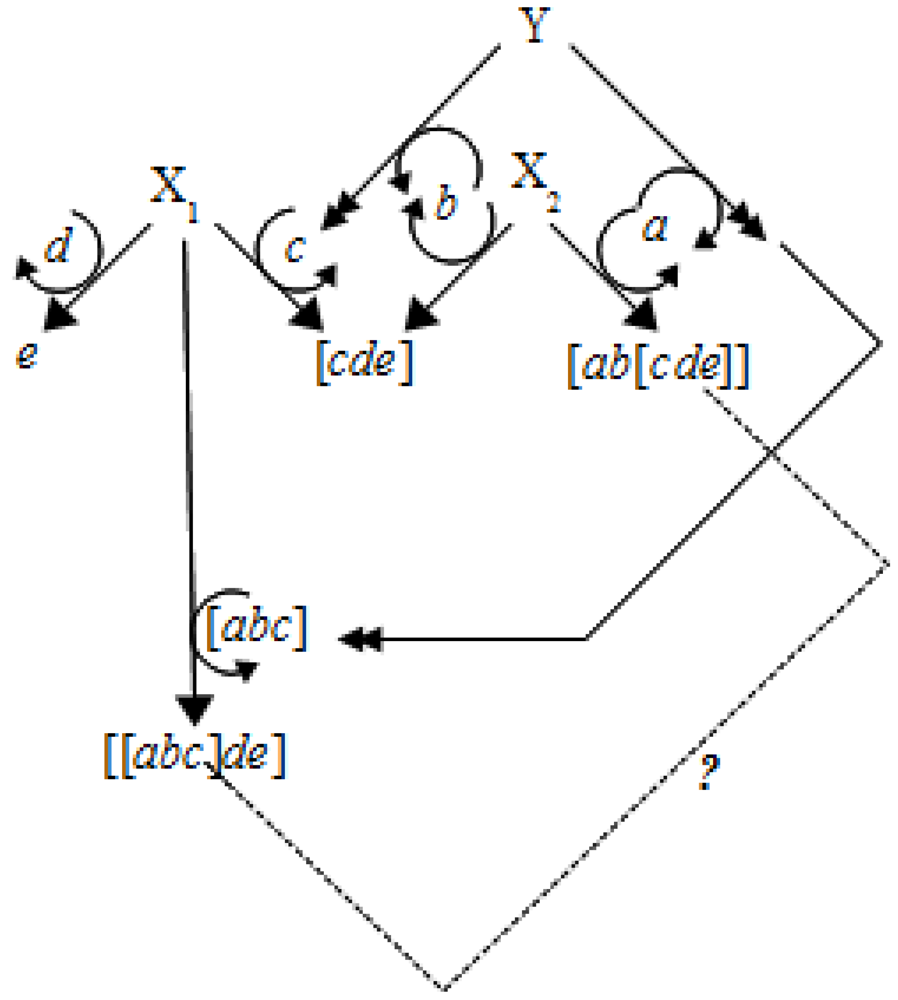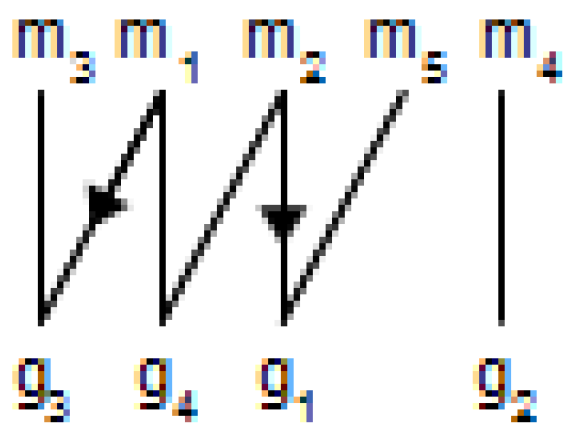1. Introduction
When a child finds a blot on the wall in an airport and the blot has a form like [P], the child may regard the blot as “pee”. But another child may regard the blot as “er”. And the other child may regard the blot as “rho”. One can think of a blot as a Latin letter, a Cyrillic letter, or a Greek letter. But what on earth are we talking about? The letter that one of the children found is different from the letters found by the other children. Can we say that we are talking about the same blot? It might just happen to be this simple case. But imagine a blot which has a more complex form such as a sequence of ideographs (Chinese characters or Kanji) or Arabic letters, and suppose that one does not have enough knowledge of the writing system of Chinese, Japanese or Arabic. When a child finds a part of the blot is similar to a certain letter, can one articulate the part from the blot with confidence?
We can say that these children have different views for the blot. And even the way articulating the world depends on the one’s view. That is to say, the blot may differ from child to child.
At a certain level of understanding, an Information Gathering and Utilizing System (abbreviated as IGUS) such as the children mentioned above can be considered to be an organizationally closed system. In cybernetics, a system is said to be
organizationally closed if its internal processes produce its own organization, thus continuously rebuilding the system’s identity in a changing environment [
1]. An IGUS as a closed information system must interpret the differences of the physical stimuli of the outer world into information for its own by utilizing the differences within itself, and incorporate the information into itself [
2]. In other words, an IGUS actively projects its internal view to obtain the information of the outer world. The view is projected on the outer world to articulate and interpret events in the outer world from the IGUS’s standpoint. Thus what we (as IGUSes) deal with are always interpretations,
i.e., representations, of the outer world through one’s own view. The world itself or
thing in itself cannot be directly dealt with or referred to.
Some researchers say that information, or more specifically, representation, should be regarded as something resides in between. To take some instances, Bateson [
3] says that “information is··· difference which makes difference,” and Heylighen [
1] says that “a representation··· constitutes an interface, it stands in between Mind and Nature, in between subject and object, in between Self and World.” Bateson gives a vague expression, while Heylighen illustrates what are adjoining the representation.
However, thinking carefully from a certain standpoint, that is, the standpoint of the present paper, this is found to bring us some difficulty. Mind and Nature, subject and object, Self and World, all of them are representations (for an IGUS) themselves. Each of them also stands in between something. We (as IGUSes) always talk only about something in between what we cannot directly refer to. It is a common difficulty, part of which can easily confirmed by casting a glance at tautologous definitions on a dictionary. To make matters worse, these representations are carved out of the world from different points of view, even when we are talking about superficially an identical thing.
In this paper, a toy model using an algebraic structure, namely, torsor, is introduced to describe and investigate an aspect of such representations. Toy model here means a simple mathematical model that reflects simplified but essential properties of target phenomena. It is used to illustrate a mechanism in order to make the phenomena easier to visualize and investigate. This research constructs the toy model by establishing a connection between the properties of representation and the structure of the algebra. By using the torsor, the toy model aims to describe naturally the representation related phenomena incorporating the “betweenness” of representation.
The structure of this paper is as follows:
Section 2 reviews two important concepts in this study: the betweenness of representation and the closure. In
Section 3, the algebraic structure used in our toy model, namely, torsor, is introduced. The toy model is described in
Section 4.
Section 5 exemplifies the toy model by several cases which are simple, but may have broad scope.
Section 6 concludes this paper.
2. Representation as Janus-Faced Closure
Several studies capture information in ternary relations. In semiology, the central notions are Signe-Signifiant-Signifié (Sign-Signifier-Signified), and in semiotics, they are Sign/Representamen- Object-Interpretant. As briefly quoted in the Introduction 1, in systems theoretic study of cognitive science, Heylighen [
1] says that:
a representation belongs neither to the realm of matter, of outside objects, of things-in-themselves, nor to the realm of pure mind or Platonic Ideas: it constitutes an interface, it stands in between Mind and Nature, in between subject and object, in between Self and World. (Emphasis added by the author of this paper)
In these studies, a representation (which is almost equivalent to a sign in this paper) is placed between something within an IGUS and (what corresponds to) something in the outer world.
To fix the terms and make the concept of representation discussed in this study clearer, an ontology of representation is presented next in
Section 2.1.
Another important concept in this study is “closure”. Suppose that “everything is a representation”, then a simple thought on a representation mechanism requires the representation of representations, the representation of the representations of representations, ··· . That is, we need an infinite hierarchy of representations which consists of meta-representations, meta-meta-representations, and so on. This is not suitable for a fundamental mechanism of IGUS as a finite physical existence. To avoid this, we introduce the closure to stop this meta-representation hierarchy. Closure also provides a mechanism to extract a stable structure from the outer world that is evasive, indeterminate and hard to figure out directly. To form a closure, the interface nature (i.e., the betweenness) of the representation plays an essential role.
General definition of the closure is described in
Section 2.2.
Summing up beforehand, in this paper, we consider a representation as what constitutes an interface that stands in between the outer world and the inner world of the IGUS under consideration. In the term of the ontology, the former corresponds to, or, can be regarded as, the Representational form, and the latter corresponds to the Proposition. They can be other representations, or, especially the former, can be substrata that are never directly referred to. (The term substratum is introduced in the next subsection.)
A solution for how to constitute a representation as an interface between substrata is provided by the closure. A representation can be considered to be a stable closure formed between indeterminate constituents, a part of outer world and the inner world of the IGUS.
2.1. Ontology of Representation
Mizoguchi [
4] defines a conceptual model of representation (mainly for engineering purposes). Because the rough meaning of the terms used in this model such as
class or
part-of relation seem evident for our purpose, the precise definitions of the terms are omitted. Interested readers should consult [
4].
A class representation is composed of two parts, form and content (as shown below).
where p/o stands for part-of relation/slot, ”form” is a slot name and ”:Representational form” is a class constraint the slot value has to satisfy. Its identity is inherited from the form, which is usually what people sense its existence. On the other hand, the content is the hidden part and it is a proposition that the author of the representation would like to convey through the representation.
Representational form has the conceptual structure shown below.
– Representational form
– Symbol sequence
– Natural language
– Spoken language
– Written language
– Artificial language
– Image
– Speech
Proposition is a content of a statement of the result of one’s recognition of every phenomenon that occurs in the real world. Events and Facts are Proposition and they are refined as follows:
– Proposition
– Design Proposition
– Procedure
– Music
– Symbol
– Specification
– Product Proposition
It is important to clearly distinguish between a representation and a represented thing. Any representation is not embodied or realized unless it becomes a represented thing.
– Represented thing
– Representation medium
– Electronic thing
Figure 1 depicts an example of a model of a representation-the letter “a”- according to this ontology. (Excerpt with minor modifications from Figure 1 of [
4])
Figure 1.
Ontology of “a”.
Since this ontology is mainly for engineering and is constructed from the standpoint that is rather too practical for our purpose, some modifications are required.
For the present study, the focal point of this ontology is that a representation is in between the Concrete, Represented thing and the Proposition, as depicted in
Figure 1. From the standpoint of this paper, the Concrete, Represented thing in this ontology does not exist independently of the IGUS, and cannot be dealt by the IGUS directly. It is not even concrete in some sense. We use the word
substratum instead of this
Represented thing in the term of this ontology. The word
substratum is used to imply the
vague, indeterminate material of which something (=
representation) is made and from which it derives its special qualities. A substratum might be a thing, but in general, it is a more vague and indeterminate “
event”,
i.e., a bunch of physical stimuli before being sensed by a certain IGUS.
The Propositions are what resides in an IGUS. In this paper, they are considered to be representations of the substrata as a part of the IGUS, or the substrata (in the IGUS) themselves. They are also not concrete against the impression of the word “proposition”.
Thus, from the standpoint of our study, the representation connects vague constituents. To be more precisely, as described next in
Section 2.2, the action to represent can be considered to be an action to yield some stableness from the vague and indeterminate constituents of the representation. The Represented thing and the Proposition in the term of this ontology are, as it were, the result of a projection of this stable representation onto each of the original substrata.
2.2. Closure
The importance of the concept of “closure” is repeatedly emphasized in many fields such as the systems theory, cybernetics, and complex systems theories. (See [
5,
6], for example.)
Mathematical definition of the closure is as follows:
Definition. Closure is an operation C on sets, C : A → A∗, with the following properties:
A set A is called closed if A∗ = A. Intuitively, such a closure of a set means that somehow “missing elements” are added to it, until no more of them are needed.
In this paper, important is the case in which a closure is formed reciprocally,
i.e., adjunctively by two sets. We formalize this using the Chu space [
7]. (For the interpretation of Chu space in this subsection, the author has referred to the description in [
8].)
Definition. A Chu space (
X,
S,
R) consists of two sets X,
S and a relation
R between them. If an element
x of
X has the relation
R with an element
s of
S, we write
Suppose that an IGUS has a Chu space within it. We assume that every element of
X represents the IGUS’s experience and every element of
S represents the nature or property of the experience.
x ⊨
s is interpreted as representing the relation that a certain experience
x has a certain property
s. Then we can have the set of all the properties the IGUS remembers when it encounters a particular experience
x:
and the set of all the common properties for a collection
Y of some experiences:
Similarly, for all experiences that have a particular property
s in common, we can have the set of all such experiences as
For all the experiences that have all its properties in a collection
T of some properties, we can also have the set of all such experiences as
Using the above sets, define two operations:
and two composites:
where PS and PX are the power set of
S and
X, respectively. Operations
γµ and
µγ are closure operators. If
Y =
Y∗, then
Y is said to be
closed. Similarly, if
T =
T∗, then
T is also said to be closed. The closed experience set
Y can be regarded as a stable articulation of experiences, and the closed property set can be regarded as stable composite idea.
All the closed experience sets and all the closed property sets both have a structure called the complete lattice, and determine each other reciprocally (Galois correspondence). Some researchers call the pair of the closed experience set and the closed property set that determine each other in this structure as a
formal concept [
9].
Such a closure formed by two sets plays a significant role in our toy model. Representations can be considered to be, in a sense, a closure of its two constituents. This construction with two sets enables dynamic yielding of views and representations. But first, an algebraic structure, torsor is introduced.
4. Toy Model-Interpretation of Torsor
In this section, a toy model to describe a certain aspect of representations is built. More specifically, we build a model which describes some kinds of consistency of representations. The toy model is built by fixing the interpretation of the structure of a torsor into the words describing the target representation phenomenon. Because the structures of representation phenomena are not fully understood yet, the interpretation determining the toy model is defined in a rather vague manner, that is, by using the undefined but suggestive words. Precise interpretation must be given formally or informally in each study of a specific phenomenon. Some such examples are provided in the next section.
4.3. Interpretation of the Para-associative Law
Recall that the para-associative law of the torsor is:
The verbatim interpretation of the requirement for the para-associative law is somewhat messy. This is also one of the reasons for using the language of algebra. Instead of analyzing in the words, we will use diagrams.
To begin with, the situation of [
abc] is depicted as
Figure 2, where
b and a are views and
X represents a substratum,
i.e., the represented, that yields
c and [
abc]. Comparing with the definition of the interpretation of the ternary operation [
abc]:
the representation of a substratum which yields the representation cin the view of b, and the representation [
abc]
is obtained in the view of a, the meaning of the diagram seems clear. The diagram corresponds to the interpretation.
Figure 2.
Ternary operation of torsor.
A formula form is also used with the figure form interchangeably. For the situation of
Figure 2, we also write
Using this diagram, the situation of the para-associative law can be depicted as in
Figure 3. where
X1 and
X2 are the substrata again, and
Y is also the substratum.
X1 and
X2 yield representations, but
Y yields views. The view
c is
Y in the view of
b, and the view [
abc] is
Y in the view of
a. The point here is the representation [
cde] is yielded in the view of
c and in the view of
b simultaneously. Starting from that point, we will trace how this diagram is built. From the transcendental standpoint, it is easy to understand.
Figure 3.
Para-associative law.
In our interpretation, for the existence of [
ab[
cde]], there must exist a substratum
X2 that yields both of [
ab[
cde]] and [
cde].
But [
cde] itself is what is define by
thus [
cde] can be yielded by the substratum
X1 other than
X2. So, more precisely, the situation is: for given (
a, )
b,
c,
d,
e ∈
H,
and Thus there must be a restriction for c and b to make the Equation (22) hold.
The coexistence of the views c and b requires the existence of the substratum Y , which yields c in the view of b, because (since there is no other assumption on the existence of the view that may yield the view c and b) the coexistence of c and b means that the representation c can be yielded by some substratum (Y ) in the view of b (and some other substratum yields b in the view c). With the existence of the substratum Y, [abc] can be yielded in the view of a.
Then, in the view of [abc], we can have [[abc]de] from the substratum X1. The diagram is completed.
Thus the para-associative law can be considered as a requirement for some kind of consistency among representations.
Naturally enough, it is not evident whether the reality conforms the para-associative law. Whether the law holds or not may depend on the case. When the law does not hold, it may be an indication that the representations may lack some consistencies. In that case, a representation used by an IGUS may be incomprehensible by another IGUS. To investigate such a matter on this toy model is expected to reveal some essential properties of the representation.




























 . Suppose that we fix the first row of this notation as 12345. Then one can represent a particular permutation only by a string, e.g., 32514 for above σ . In other words, we consider H is isomorphic to the permutation S5 of five elements.
. Suppose that we fix the first row of this notation as 12345. Then one can represent a particular permutation only by a string, e.g., 32514 for above σ . In other words, we consider H is isomorphic to the permutation S5 of five elements.  -114523. Then
-114523. Then 





 = (G, M, I) consists of two sets G and M and a relation I between G and M. The elements of G are called the formal objects and the element of M are called the formal attributes of the context. When an object g is in the relation I with an attribute m, we write g ⊨ m or (g, m) ∈ I and read it as “the object ghas the attribute m”.
= (G, M, I) consists of two sets G and M and a relation I between G and M. The elements of G are called the formal objects and the element of M are called the formal attributes of the context. When an object g is in the relation I with an attribute m, we write g ⊨ m or (g, m) ∈ I and read it as “the object ghas the attribute m”. 

 (G, M, I) denotes the set of all concepts of the context (G, M, I).
(G, M, I) denotes the set of all concepts of the context (G, M, I). 

 : G → G × M is defined as extracting the minimum arrow-closed subcontext containing any specified subset H0 of the formal object G. Similarly, an operation
: G → G × M is defined as extracting the minimum arrow-closed subcontext containing any specified subset H0 of the formal object G. Similarly, an operation  : M → G × M is defined as extracting the minimum arrow-closed subcontext containing any specified subset N0 of the formal attribute M. These operations, combined with projection, are defined for later convenience:
: M → G × M is defined as extracting the minimum arrow-closed subcontext containing any specified subset N0 of the formal attribute M. These operations, combined with projection, are defined for later convenience: 





 (G, M, I). Hence by corresponding a set of formal concepts with representation, we can handle the view and the representation uniformly. Formal contexts brought by these views are arrow-closed subcontexts, hence they are comptible with the original context C = (G, M, I). On these assumptions, the axioms of the torsor are automatically satisfied.
(G, M, I). Hence by corresponding a set of formal concepts with representation, we can handle the view and the representation uniformly. Formal contexts brought by these views are arrow-closed subcontexts, hence they are comptible with the original context C = (G, M, I). On these assumptions, the axioms of the torsor are automatically satisfied. 














